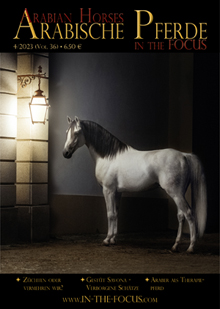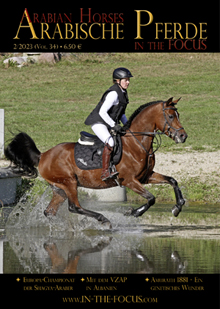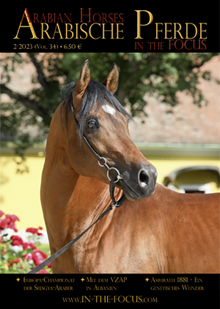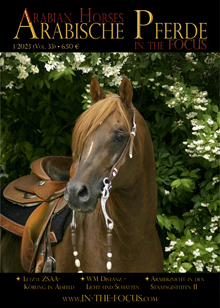Bairaktar was the crown of the stud, an eminent animal, whose offspring stand unrivaled. The King used him for some time as riding horse, while there was no evidence yet about his prepotency; when he also convinced in this respect, he was used as sire and remained in this position as long as his strength would allow“.
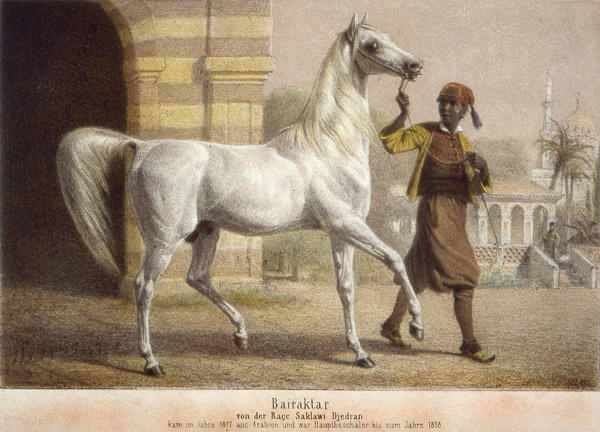
This is, what we read posthumously about the desertbred stallion Bairaktar db in the history books of the breed and indeed, Bairaktar – his name means „standard bearer“ – was retrospectively without any doubt the most important stallion in the history of the Royal Stud of Weil of the Kings of Württemberg. But that was not the case right from the beginning.
Even before the foundation of the Royal Stud of Weil in September 1817, the two stallions Bairaktar and Tajar arrived in Europe in May 1817, imported by Baron von Fechtig. Both stallions belonged to the race Saklawi Djedran, and von Fechtig had acquired them through a middleman in the Orient.
Both stallions were brought to the Royal Stables at first, where the inventory lists those horses, the King intended to keep as his private propberty. This list gives their value: Tajar was prized with 1000 Louis d‘Or, while Bairaktars prize was only 600 Louis d‘Or. This means, at the time Tajar was valued higher than Bairaktar. And while Tajar was used as sire in Weil already in the year of his arrival, Bairaktar was used only one year later (1818). He covered the following two seasons (1818-1819), but still standing in the shadow of Tajar who got about twice as many mares than Bairaktar. Was it because of the broodmare band, which consisted at the time of Transylvanian, Turkish, Russian and only one „pure Arabian mare“ (Murana I), that Bairakatars offspring did not convince fully?
When in August 1819 a transport of desert-bred Arabian stallions of Count Rzewuski arrived in Weil, the best of them, Goumousch Bournu, became chief sire in Weil alongside Tajar, and Bairaktar was left in the Royal Stables. Here he remained the following four years as riding horse of the King [1820-1824], and he did an „excellent service“. During covering season, he obviously was also used to serve the farm mares around Altshausen (Upper Swabia), where he was stabled in the Royal Stables at the castle there, the country estate of the Royal family, that was used as stopover when travelling from Stuttgart to Friedrichshafen, but also for occasional hunting holidays. In Altshausen other oriental stallions were also standing at stud, among them also some of the Rzewsuki-stallions, such as Sheraky, Wechaby and Hurschid. The foals of these „Royal Stallions“ out of farm mares were sometimes bought back by the King to support the farmers.
When Goumousch Bournu died far too early in June 1824, Bairaktar was finally used as sire again during the covering season of 1825. Finally, the brood mares consisted of predominantly desert-bred mares and he served the best of them, such as Schakra I db, Kabron I db, Elkanda I db, Sady III 1821, Hamdany I db, Hasfoura db, and Abuloulou db.
In 1828 he had then probably convinced by his offspring, for it is said: „Among the desert-bred stallions Bairactar claims the first place. He has excellent bones and is strong for his size. His tendons could be more clear, but since he was used for a long time and intensively by the king, and as he also had received fire, it may have been better before. His offspring are good.“
In the mid-1840s, there were about 50 colts at Kleinhohenheim, „among which were many excellent, who were later on used as sires, especially the sons of Bairaktar“. Prof. Rueff recalls about Bairaktar: „This desertbred stallion was of noble forms and especially strong and correctly built, his movements excellent, yet alone his neck not slender and long enough, and his shoulders a little steep. Bairaktar inherited very good and is among the best Arabs, who were imported to Europe ever.“
On the death of Bairaktar, King William noted in his private notes in plain words: „On 17th February [1839], Bairakter, the first sire of the stud since its foundation died“. Bevor, the stallions showed colic symptons over about 30 hours, then he got paralysed and couldn‘t get up anymore. Eduard Hering, who treated the horse and dissected him after his death, reported: „In Bairaktar, I found fifteen square gallstones, weighing 6 ½ Drachmen together.“ His skeleton was given to the veterinary school at Stuttgart (Hohenheim). Looking at the skeleton, which was at the Museum of the University of Hohenheim until the 1980ies, and now stands at the stud museum Offenhausen (near Marbach), we can see, that Bairaktar might have had trouble eating, as he had some very remarkable steps in his molar teeth.
His influence as a breeding stallion was never surpassed by any horse in Weil, where he had sired more than 200 foals and was fertile until his end.
Gudrun Waiditschka
Please note: This article is an extract of the book „Royal Horses“, celebrating the 200-year-anniversary of the Weil-Marbach breeding, that will be take place in 2017. Release date of the book is spring 2017. More information here!(sorry, in German only…)









